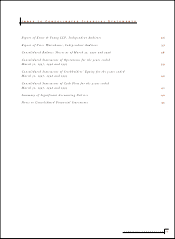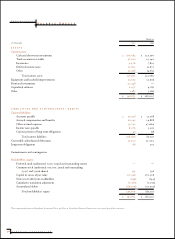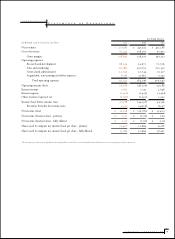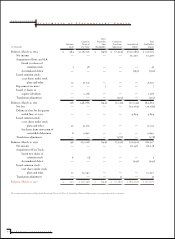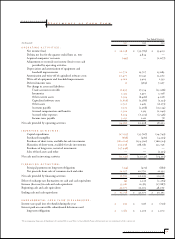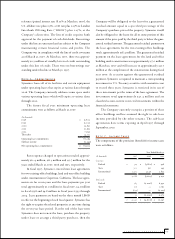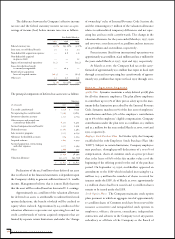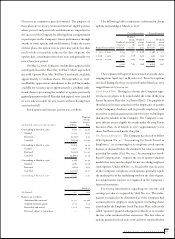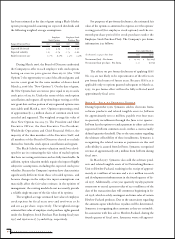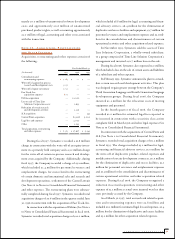Symantec 1997 Annual Report Download - page 45
Download and view the complete annual report
Please find page 45 of the 1997 Symantec annual report below. You can navigate through the pages in the report by either clicking on the pages listed below, or by using the keyword search tool below to find specific information within the annual report.
43
SYMANTEC CORPORATION
expense were $35.1 million, $34.5 million and $28.0 million
in fiscal 1997, 1996 and 1995, respectively.
Symantec recognized approximately $3.0 million of
North American net revenues in the March 1995 quarter and
$7.2 million of international net revenues in the June 1995
quarter that had been previously deferred by Central Point
in accordance with Statement of Financial Accounting
Standards No. 48.
C a sh Equivalents, Short-Term
Investments and Restricted Investments
Symantec considers investments in highly liquid instruments
purchased with an original maturity of 90 days or less to be
cash equivalents. All of the Company’s cash equivalents,
short-term investments and restricted investments, consisting
principally of commercial paper, corporate notes, U.S. treasury
notes and certificates of deposit, are classified as available-
for-sale as of the balance sheet date. These securities are
reported at amortized cost, which approximates fair value,
and therefore, there are no unrealized gains and losses
included in stockholders’ equity. Realized gains and losses
and declines in value judged to be other-than-temporary are
included in interest income. The cost of securities sold is
based upon the specific identification method.
Inventories
Inventories are valued at the lower of cost or market. Cost is
principally determined using currently adjusted standards,
which approximate actual cost on a first-in, first-out basis.
Equipment and Leasehold Improvements
Equipment and leasehold improvements are stated at cost,
net of accumulated depreciation and amortization.
Depreciation and amortization is provided on a straight-line
basis over the estimated useful lives of the respective assets,
generally the shorter of the lease term or three to seven years.
Capitalized Software
Purchased product rights are comprised of acquired software
(“product rights”) and are stated at cost less accumulated
amortization. Amortization is provided on the greater of the
straight-line basis over the estimated useful lives of the respec-
tive assets, generally three to five years, or on the basis of the
ratio of current revenues to current revenues plus anticipated
future revenues. In fiscal 1997, Symantec wrote off approxi-
mately $0.6 million of unamortized purchased product rights
related to its network administration technology, as a result of
the sale of this business unit to Hewlett-Packard in March 1997.
In fiscal 1997, Symantec capitalized approximately $7.7
million of capitalized software development costs, primarily
related to network administration technology, which was sold
to Hewlett-Packard in March 1997, resulting in the write off
of approximately $7.0 million of unamortized costs during
the fourth quarter of fiscal 1997 (See Note 9 of Notes to
Consolidated Financial Statements). Amortization expense
for capitalized software development costs during the fourth
quarter of fiscal 1997 totaled approximately $0.3 million.
Prior to fiscal 1997, capitalization of certain software
development costs in accordance with Statement of Financial
Accounting Standards No. 86 did not materially affect the
Company, except for amounts capitalized by Delrina prior
to its acquisition by Symantec in fiscal 1996. Delrina did not
capitalize any software development costs in fiscal 1996 and
capitalized approximately $6.3 million in software develop-
ment costs in fiscal year 1995, which were substantially
written off in fiscal 1996 as the result of the de-emphasis of
Delrina Windows 3.1 and certain other products. The related
amortization expense was approximately $5.6 million and
$4.0 million in fiscal 1996 and 1995, respectively.
Income Taxes
Income taxes are computed in accordance with Statement of
Financial Accounting Standards No. 109, “Accounting for
Income Taxes.”
Net Income (Loss) Per Share
Net income (loss) per share is calculated using the treasury
stock or the modified treasury stock method, as applicable,
if dilutive. Common stock equivalents are attributable to out-
standing stock options. Fully diluted earnings per share
includes the assumed conversion of all of the outstanding
convertible subordinated debentures.
Concentrations of Credit Risk
The Company’s product revenues are concentrated in the
personal computer software industry, which is highly
competitive and rapidly changing. Significant technological
changes in the industry or customer requirements, or the
emergence of competitive products with new capabilities or
technologies, could adversely affect operating results. In addi-
tion, a significant portion of the Company’s revenue and net
income is derived from international sales and independent




